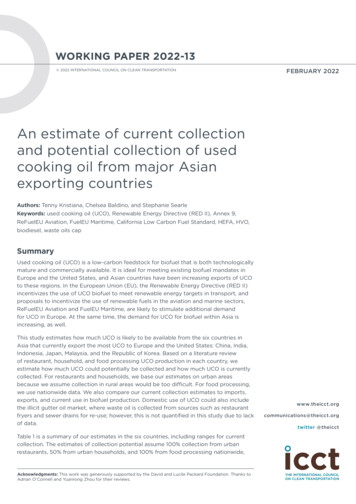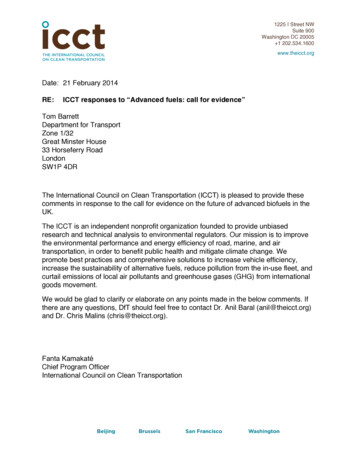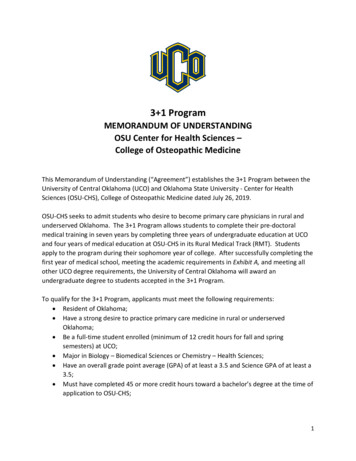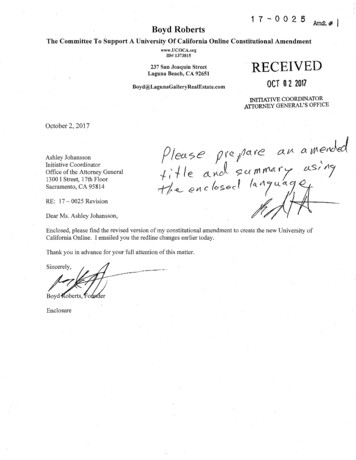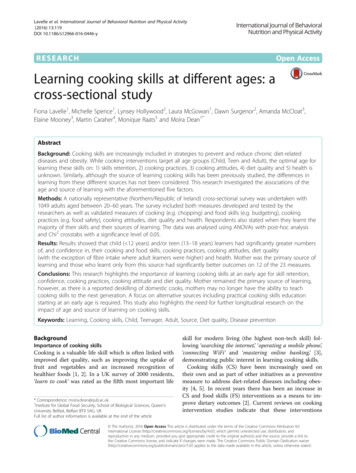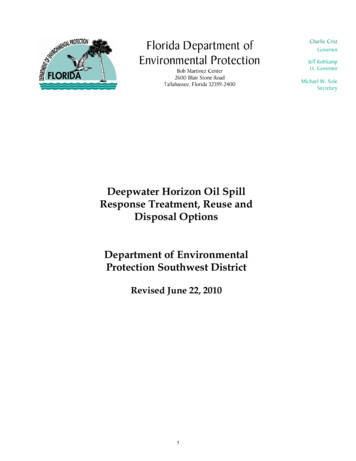
Transcription
9Used Cooking Oil(UCO) as biofuelfeedstock in the EU
Used Cooking Oil (UCO) asbiofuel feedstock in the EUAuthors: Anouk van Grinsven, Emiel van den Toorn, Reinier van der Veen, Bettina KampmanDelft, CE Delft, December 2020Publication code: 20.200247.144Cocking Oil / Reuse / Biofuels / Feedstock / EU / Regulation / DirectivesClient: Transport & EnvironmentPublications of CE Delft are available from www.cedelft.euFurther information on this study can be obtained from the contact person Anouk van Grinsven (CE Delft) copyright, CE Delft, DelftCE DelftCommitted to the EnvironmentThrough its independent research and consultancy work CE Delft is helping build a sustainable world. In thefields of energy, transport and resources our expertise is leading-edge. With our wealth of know-how ontechnologies, policies and economic issues we support government agencies, NGOs and industries in pursuit ofstructural change. For 40 years now, the skills and enthusiasm of CE Delft’s staff have been devoted toachieving this mission.1200247 - Used Cooking Oil (UCO) as biofuel feedstock in the EU – December 2020
ContentAbbreviations3Summary41Introduction1.1 Background1.2 Objective1.3 Methodology and scope1.4 Content of this report888892Demand for UCO and UCOME2.1 Introduction2.2 UCO is used for various applications2.3 Current UCOME consumption2.4 Projected future consumption of UCOME2.5 Conclusions1010101220263Supply of UCO3.1 Introduction3.2 Collection of UCO3.3 Current EU supply of UCO3.4 Supply potential in the EU3.5 Non-EU supply3.6 Total supply for the EU3.7 Conclusion28282832353739414Comparison of supply and demand4.1 Current supply and demand4.2 Future supply and demand4.3 Displacement effects4.4 Conclusion42424243435Monitoring and verification5.1 Introduction5.2 UCO prices5.3 Rules and regulations5.4 Chemical properties5.5 Fraud5.6 Displacement effects5.7 Identified improvements5.8 re582200247 - Used Cooking Oil (UCO) as biofuel feedstock in the EU – December 2020
SCCLIFNMRREDPYGCMSUCOUCOME3Bovine spongiform encephalopathy – mad cow diseaseEuropean CommissionEuropean UnionEuropean Waste-to-Advanced Biofuel AssociationFatty Acid Methyl EsterFatty AcidsFourier-transform infrared spectroscopyHydrotreated Vegetable OilInternational Civil Aviation OrganisationDutch transport authority - Inspectie voor Leefomgeving en TransportInternational Maritime OrganisationInternational Sustainability & Carbon CertificationLaser-induced fluorescenceNuclear Magnetic ResonanceRenewable Energy DirectivePyrolysis Gas Chromatography Mass spectrometerUsed Cooking OilUsed Cooking Oil Methyl Ester – in this report we use the term UCOME forbiodiesel based on UCO in general, which could also include HVO200247 - Used Cooking Oil (UCO) as biofuel feedstock in the EU – December 2020
SummaryIntroduction to the studyThe demand for Used Cooking Oil (UCO) for biodiesel production in the EU is likely toincrease significantly, especially in the light of the Renewable Energy Directive II. Besidesoffering a means to reduce CO2 emissions in road transport, UCO is also often mentioned asfeedstock for renewable fuels for maritime shipping and aviation. Given this likely increasein demand, T&E would like to have more insight into the use, availability and origin of UCOand UCO-based biodiesel, as well as into potential risks and sustainability issues. To this endthis study aims to provide a better understanding of:— developments in demand for UCO;— developments in the current and potential supply of UCO;— monitoring and verification issues in relation to possible fraud.Current UCO/UCOME consumption in EU transportUCO can be used as feedstock for biodiesel production, which is then called UCOME 1.UCOME consumption in the EU UK is currently around 2.85 Mt, which accounts for 19% oftotal EU biodiesel consumption. However, only ten EU UK Member States consumesignificant volumes of UCOME. Germany, Ireland, Hungary, Netherlands, Portugal, UK,Slovenia and Bulgaria have higher shares of UCOME. The latter two started just veryrecently with consuming UCO-based biodiesel.All countries that have a stable and high share of UCOME (NL, DE, HU, IE, PT, UK) havepolicy incentives for UCOME in place: double counting or, like Germany, anothercompetitive advantage. Several countries have an 80% or higher share of UCOME in biodieselconsumption. Only a few Member States publish information on the origin of UCO forconsumption in transport, but overall EU data shows that about half of UCO is beingimported, mainly from Asia.Current use of UCO for biodiesel production in the EUBiodiesel production in the EU UK is dominated by only five Member States: Germany,France, Italy, Spain and the Netherlands, and amounted to 2.8 Mton in 2019. 18.5% of thebiodiesel produced in the EU is made from UCO, which is similar to the 19% share inconsumption, and almost all production in the EU is produced for the European market.Figure 1 presents the development of feedstock for biodiesel produced in the EU.1UCOME (Used Cooking Oil Methyl Ester) is technically only one type of UCO-based biodiesel, but we use the termfor all UCO-based biodiesel in this report.4200247 - Used Cooking Oil (UCO) as biofuel feedstock in the EU – December 2020
Figure 1 – Feedstock for EU biodiesel production (incl. HVO) (in Mton)Feedstock for EU biodiesel production161412Mton10864202016Rape oilPalm oil2017UCOSoy oil2018Sunfower oilTallow & greases2019othersSource: (ISTA Mielke GmbH, 2020).Since 2014, net imports of UCO to the EU UK have significantly increased, with China,Indonesia, Malaysia, Russia, the US and Saudi Arabia as the main countries of origin. In 2018almost half of the UCO used as biodiesel feedstock was imported from outside the EU, thisincreased to more than half in 2019.Import data for UCOME are not available, but total biodiesel imports are known: 3.2 Mt netimport in 2019. The main countries of origin of biodiesel imports to the EU are Argentina,China, Indonesia and Malaysia (EC, DG TRADE, 2020). The Netherlands, Spain and Belgiumare responsible for 97% of the imports (UFOP, 2019). Main export destinations of biodieselproduced in the EU are Norway, Switzerland, US, and Peru. Part of this biodiesel is likely tobe UCOME, but whereas statistics on feedstock of biodiesel produced in the EU areavailable, this is not the case for imported biodiesel.Supply of UCOUCO is mainly ‘generated’ by the food-processing industry, restaurants and other cateringcompanies2. Current UCO collection in the EU UK is estimated at 0.7–1.2 Mton/yr. Another1.4 Mton/yr is imported.The total UCO and UCOME potential for the EU UK, i.e., the sum of the EU UCO supplypotential and the import potential from non-EU countries, is 3.1-3.3 Mton/yr, of which 3050% comes from outside the EU. It will require years to establish collection systems andimprove collection rates to reach the global maximum potential. Collection of UCO fromindustry and restaurants is generally easier and less costly to perform than collection fromhouseholds, because it becomes available in larger quantities at fewer locations. As a2Organisations with a catering service such as hospitals and schools could also be considered to be part of thissector.5200247 - Used Cooking Oil (UCO) as biofuel feedstock in the EU – December 2020
result, UCO collection from the professional sector is currently much more developed andpracticed than collection from households.Supply compared to demandTable 1 provides an overview of our main conclusions on demand and supply of UCOME.Current EU UCO/UCOME supply and imports add up to a total supply of 2.1-2.6 Mton/year.The highest estimate of supply is somewhat lower than current EU UK consumption ofUCOME, of 2.8 Mton, which illustrates the uncertainty of the data.Future EU UK demand estimates show a potential strong increase in UCOME consumption to6.1 to 6.4 Mton/year in 2030, in a scenario where UCOME achieves a 1.7% share in thetransport fuel in all countries in the EU UK in 2030 (1.7% is the maximum cap set the REDII). This can be seen as a high-demand scenario as long as the 1.7% cap remains in place.About 17-19% of this demand, 1.0-1.1 Mton, would then be used in EU aviation3, theremainder in the other transport modes. This demand would exceed our estimate of theUCO/UCOME supply potential for the EU of 3.1-3.3 Mton/year significantly. Some literaturesources arrive at a much higher potential global supply than we have used (up to 34Mton/yr), but these did not further specify the underlying assumptions including the extentto which UCO demand for other applications was taken into account.Table 1 - Demand and supply of UCO/UCOME, for the current situation and the potential in 2030DemandCurrent situation (2019)Potential for 2030Mton/yrMton/yrEU UK2.86.1-6.4Global5.12Potential global demand as a transportfuel*SupplyEU UK (excl. imports)27-370.7-1.2Imports to EU UKTotal supply EU UK1.71.41.42.1-2.63.1-3.3* Assuming that in 2030 the global share of UCOME in renewable transport fuels equals that of EU (11%-15%).Apart from this growing demand in the EU, UCO and UCOME demand from other countriesand sectors worldwide is also likely to increase. To illustrate this: if the EU share of UCOMEin renewable transport fuels is also achieved on a global scale in 2030, 27-37 Mton/yrUCO/UCOME would be needed. The policy developments in aviation and maritime shippingare particularly relevant here, since alternative fuels are expected to play a crucial role inachieving their climate ambitions.Fraud risksUCO can be sold at higher prices than virgin oil, since fuel suppliers can count UCO-basedbiodiesel twice for meeting their renewable energy targets in the countries that use doublecounting as a policy incentive. In recent years, the market prices of UCO and UCOME weresignificantly higher than those of virgin oil and virgin oil-based biodiesel (spot market pricesof UCOME in North-West Europe were 40 to 65% higher than those of FAME, end of 2019/36Defined as flights departing from the EU and domestic flights in the EU.200247 - Used Cooking Oil (UCO) as biofuel feedstock in the EU – December 2020
beginning of 2020). The double counting mechanism in combination with high market pricesincentivises the use of UCOME, but it also creates an incentive for illegal practices: to ‘turnvirgin oil into UCO’, mix virgin oil into UCO or artificially increasing the production of UCO.Research is still ongoing to develop a cheap, quick and accurate measurement method thatcan detect fraud in the delivery and use of UCO as a feedstock for biodiesel. In the contextof this report, such research is especially relevant for the detection of UCO adulteration,i.e. adding virgin oil to UCO. A remaining question is whether the artificial treatment(additional chemical processing) of virgin oil to make it similar to UCO can be detected aswell.A high demand combined with limited supply requires strong rules and regulations, butcurrent rules and regulations lead to a non-transparent certification process of thesustainability of UCO. Weaknesses in the certification process are also applicable to otherfeedstocks, but due to the higher economic value of UCO and UCOME fraud risks are morelinked to this feedstock. Combining this observation with the difficulty to detectadulteration of UCO with virgin oil, it becomes apparent that risks of fraud do exist. Fraudcan include:— mixing of virgin oil and UCO;— issuing fake proofs of sustainability;— leaving out deliveries on mass balances, so that the mass balance looks correct onpaper;— issuing certificates twice for the same batch;— artificial increase of the production of UCO.Factors that contribute to the likeliness of fraud are a high UCO price, low transparency,low traceability, the opportunity for double bookkeeping and lack of verificationprocedures.Improvements to prevent fraud in the futureSeveral improvements are announced both by the European Commission as well as themarket to improve the monitoring and verification practices and to prevent future fraudcases. A large fraud case discovered in 2019 has increased the sense of urgency, and hastriggered the certification scheme International Sustainability & Carbon Certification (ISCC)to revise its procedures. This case involved a Dutch company that was suspected to sellbiodiesel based on virgin oil as UCOME, which had a higher market value. The EuropeanCommission is working on a central database for biofuels, while the initiative Bioledger isdeveloping a blockchain-compliance database in cooperation with the Roundtable onSustainable Biomaterial (RSB), certification bodies and the waste-based biodiesel sector.Individual Member States are working on improvements at the national level as well.For example, the Spanish regulator has updated the Spanish biofuels framework, obligingproducers to provide digitally signed verification of the sources and quality of feedstocksand biofuels production each month, as well as annual reports (Argus, 2020b).7200247 - Used Cooking Oil (UCO) as biofuel feedstock in the EU – December 2020
1 Introduction1.1BackgroundWith the Renewable Energy Directive II (RED II) the EU aims to stop the growth in biofuelsfrom food and feed crops and phase out biofuels from palm oil due to the high indirect landuse change impacts. Instead, the increase in renewable energy in transport should comefrom advanced (bio)fuels, which may be produced from feedstocks which are listed underAnnex IX of the RED II. This includes the use of waste oils and fats, including the use of usedcooking oil (UCO) as listed under Annex IX B. Biodiesel production from waste oils and fats isa relatively mature and cheap technology compared to biodiesel production from feedstockslisted under Annex IX A of the RED II. These also require the set-up of new productionfacilities, while UCO can be processed in current FAME and HVO production facilities4.The contribution from Annex IX B feedstocks to the renewable energy target in transport islimited to 1.7% of total energy consumption in transport (RED II Art. 27.1(b)) (althoughnational governments can deviate from this cap if they get permission from the EuropeanCommission). Also, biofuels from these feedstocks may be counted twice towards therenewable energy in transport target (Art 27(2(a)). Besides the opportunities of usedcooking oil as a biofuel feedstock, there are also concerns about potential drawbacks due tothe limited sustainable availability of UCO, and possible fraud. As UCO is becoming morepopular, these concerns are becoming increasingly important.T&E would like to have more insight into the use, availability and origin of UCO as well asinto potential risks and sustainability issues related to the increased use of UCO for biofuelsand has therefore commissioned this study.1.2ObjectiveThe main aim of this study is to provide an overview of the sustainability issues and risksrelated to the increasing use of UCO. To this end this study aims to provide a betterunderstanding of:— developments in demand for UCO;— developments in the current and potential supply of UCO;— monitoring and verification issues in relation to possible fraud.1.3Methodology and scopeThis study is based on desktop research and statistical analysis of data sources.Where necessary stakeholders have been contacted.The scope of this study covers three dimensions: the value chain (from feedstock toapplication), geography and the time frame. These three elements constitute theframework in which the research questions are assessed.48FAME Fatty Acid Methyl Esters, HVO Hydrotreated Vegetable Oil. Both are types of biodiesel.200247 - Used Cooking Oil (UCO) as biofuel feedstock in the EU – December 2020
Feedstocks/production chainsThe production process of biofuel from UCO is similar to that of biofuel from virgin (plant)oil, with some simple additional steps. In this study, we will consider UCO (and other animalfats) from the moment they acquire the status of used product until their application in theEU or their potential application elsewhere.The focus regarding application of UCO will be on feedstock for transport fuel, but otherapplications that might compete for its use, like animal feed, will be discussed briefly aswell.Within this report we use the term UCOME for UCO-based biodiesel. Although this istechnically UCO-based FAME (UCOME is an abbreviation for Used Cooking Oil Methyl Ester),we use it for all UCO-based biodiesel, including both FAME and HVO. Worldwide HVOproduction (from all feedstocks) is about 11% of total biodiesel production, with almost 3 Mtannual HVO production in the EU. Next to the EU, Singapore is a major consumer of HVO,with 1.8 Mt (UFOP, 2019). Overall, FAME currently dominates biodiesel production andconsumption and consequently import and export as well.Geographical scopeThe geographical scope of this report Is focussed on the EU27 plus the UK. At this momentin time most EU data sources still include the United Kingdom. Other countries and parts ofthe world are considered only where the role of non-EU countries in import and potentialfuture demand is discussed.Time frameThis study focuses on the current situation (in most instances the most recent data was2018) and the expected supply and demand in 2030.1.4Content of this reportThe structure of the report is as follows:— First of all, Chapter 2 describes the demand for UCO and UCOME in the EU.— Chapter 3 focusses on the supply of UCO and especially on the collection of UCO withinthe EU.— Chapter 4 then compares the outcomes of Chapters 2 and 3, i.e. demand and supply ofUCO and UCOME. This chapter also discusses potential displacement effects that canresult from increasing demand.— In Chapter 5 current risks associated with monitoring and verification and a number offraud cases are described.— Finally, Chapter 6 provides an overview of the main conclusions.9200247 - Used Cooking Oil (UCO) as biofuel feedstock in the EU – December 2020
2 Demand for UCO and UCOME2.1IntroductionIn the EU, 80% of renewable energy in transport consists of biofuels and almost 90% of this isbiodiesel.5 Biodiesel can be derived from a range of products, including food and feedcrops, animal fat and UCO. This section describes the current and estimated future demandof UCO in the transport sector and other sectors.First, an overview of various applications of UCO is presented in Section 2.2. Secondly,a quantitative overview of current UCOME consumption will be given in Section 2.3.This will be done at global level, EU level and where possible at Member State level.We will describe biodiesel production and the origin of feedstocks for biodiesel production.However, not all Member States have information available on the origin of UCO at the levelof final consumption.After an overview of consumption and production, estimates for future use of UCO andrelevant trends are described in Section 2.4, taking into account the new provisions of theRED II and growing demand which can be expected from aviation and maritime shipping.This chapter ends with a summary of conclusions in Section 2.5.Concerning the dataData used in this chapter have several origins, which do not as a rule exactly correspondwith each other, mainly due to differences in scope. First, there is the important distinctionbetween production and consumption. Oil World (by ISTA Mielke GmbH), F.O. Licht (asquoted in UFOP annual report) and EU Biofuels Annual give mainly data for production.SHARES (Eurostat) and national reports (mostly) provide data for consumption. We aim touse the more recent data, but had to use some older sources where recent data were notavailable. Secondly, whereas sources sometimes refer to the same category and year, datadoes not necessary reflect the exact same values, but show small differences. This might becaused by different information (reporting formats) or calculations, for example due tosmall differences in conversion rates. Where possible we have tried to align the datasources used to the data sources used in any other publications of T&E on this matter.2.2UCO is used for various applicationsUCO is a valuable feedstock for various applications. UCO is often referred to as waste, butthis depends on the definition of waste. For example, UCO is already being reused as animalfeed in some countries.The focus of this report is the use of UCO in the production of biodiesel. However, due toits fatty acid content, and despite being a waste product, UCO also contains valuablecomponents for other applications while being cheaper than virgin oil. Next to biodiesel,510The European Union Member States Main Energy and Climate Indicators200247 - Used Cooking Oil (UCO) as biofuel feedstock in the EU – December 2020
UCO is mainly used for animal feed (outside the EU) and as raw material for severalchemical processes.Animal feedThe nutritious ingredients of UCO make it a possible element of animal feed. However,since UCO in unprocessed form contains harmful components and because it has been incontact with food, very strict safety criteria need to be fulfilled when it relates back to thehuman food chain. The BSE crisis of the 1990’s6, that was caused by a similar cycle ofproducts, was the direct motive to ban UCO as a component for animal feed in the EU.In many countries outside the EU, such as China and the USA, these safety measures are notin place and is UCO still a common component for animal feed.Although cheaper than virgin oil and widely used, UCO is not a crucial nor the maincomponent of animal feed. Other by-products from the vegetable oil industry like oil cakesand meals that result from oil pressing and are not contaminated with food products aremuch more essential. Furthermore, even though by-products are used as animal feed, itmainly consist of primary agricultural products such as corn, sorghum, barley, etc.Food industryAccording to Ecofys (2013a), 90% of UCO that is collected in China is illegally re-used in thefood industry. In Indonesia, gutter oil is commonplace as well. It poses direct health risksand is therefore banned in all countries.Use in the oleochemical industry and heat and energy generationUCO can also be used for chemical and biological processes. It can for example beprocessed to obtain pyrolytic oil, as a source of energy to produce hydrogen gas. It can alsobe chemically transformed to bio lubricants, graces, resins, and biodegradable polymers(Panadare & Rathod, 2015).Furthermore, UCO can be easily transformed into soap by saponification and it can also beburned directly for energy generation. However, due to the diverse and often low quality ofUCO, the chemical industry gives preference to products of higher standards, like animalfats. Also, some food-processing companies use their UCO as a feedstock in their anaerobicdigestors (along with other biological waste streams) to produce biogas (Ecofys, 2013a).In the EU, the oleochemical industry uses 70.000 ton UCO annually. The industry has raisedconcerns that the increasing demand from the transport sector will result in replacement bypalm oil (Ecofys, 2013b).6BSE is commonly known as mad cow disease, seehttps://en.wikipedia.org/wiki/Bovine spongiform encephalopathy11200247 - Used Cooking Oil (UCO) as biofuel feedstock in the EU – December 2020
UCOME as dominant applicationWhile different applications are technically possible, biodiesel (i.e. UCOME) is projected toremain the dominant application for UCO (Allied Market Research, 2020). This is mainly dueto the fact that conversion to biodiesel is stimulated by policy and hence represents thebest economic option.There is to date no extensive literature on the exact land use and food price effects of theapplication of UCOME (Delzeit, et al., 2019). We describe potential displacement effects inSection 4.3.2.3Current UCOME consumptionDriven by the policy incentives for UCOME, UCO has become an important feedstock forbiodiesel. It needs to be purified and can then either be turned into FAME or HVO, followingthe same production route as virgin oil. At the moment, FAME is by far the largest output,mainly due to lower production costs than HVO. The next paragraphs describe current UCObased biodiesel consumption worldwide and in the EU.2.3.1 Worldwide biofuel mandates and UCOME shareIn North- and South America, Europe and Asia, policies are aimed at increasing the share ofrenewable energy in final energy consumption of the transport sector. These often consistof renewable energy or biofuel mandates imposed on fuel suppliers delivering fuels tonational markets, and these mandates and renewable energy targets are mostly met bybiofuels until now.Many countries have general biofuel targets, but since UCO is almost exclusively used forbiodiesel, we provide in Table 2 an overview of specific biodiesel mandates outside the EU.On average, mandates vary between 2-10% with some higher mandates being applied inMalaysia and Indonesia, where large amounts of palm oil are being produced. One canconclude from this overview that biodiesel use in transport is driven by demand policies inmany of the most important transport regions in the world. Note that these mandatesreflect the targets, the table does not imply those shares have been realised in practice.Table 2 – Biodiesel blending mandates around the world (non-EU countries only)CountryBiodiesel ruguay6%South KoreaUSA5%TaiwanSource: (Biofuels Digest, 2019).12Biodiesel blend200247 - Used Cooking Oil (UCO) as biofuel feedstock in the EU – December 20202%2.5%2%
Table 3 gives an overview of renewable energy mandates for transport for EU MemberStates.Table 3 - Renewable energy mandates for diesel in the EU UK in 2020 (GAIN, 2020b)Member StateRenewableenergy mandate(% of transportfuel*)UnitMember a1 (secondgeneration)VolLithuania6VolMalta5.75 (all)CalNetherlandsCyprusCzech RepublicDenmarkRenewableenergymandate(% of transportfuel*)Unit9 (all)CalLuxembourgEstonia16.4 (all)Cal8.5-9.1 (all)CalPortugal10 6GHG savingsSlovakia7.6-8.2 (all)CalGreece7CalSlovenia7.5 (all)CalCroatia7.49CalSpain8.5 (all)8.2CalSweden11 (all)VolUnited KingdomHungaryIrelandCal19.210.637GHG savingsCal* The scope of the denominator is defined in the RED.Data is for diesel mandate if a county has a separate renewable energy target for diesel. In other cases, thegeneral target for transport fuel is provided. This is indicated by (all).Cal energy content.Vol volume based.Worldwide, UCO is a relatively minor feedstock for biodiesel (FAME/HVO). In 2019, UCOMEmade up 5.12 Mt of the 45.69 Mt biodiesel produced worldwide (ISTA Mielke GmbH, 2020).The most important feedstocks are various types of virgin oil: palm oil (38.5%, 2019), soy oil(25%, 2019) and rapeseed (14%, 2019, of which 85% EU). UCO accounts for 11% of globalbiodiesel consumption in 2019, mainly due to the US and EU. UCO is only in the EU — where40% of global biodiesel is consumed — and in the US a considerable, at least 10% of total,feedstock for biodiesel (UFOP, 2019).2.3.2 UCOME consumption per EU Member StateMember states enjoy a certain freedom regarding the implementation of the RED and REDII, and hence, there are differences in national regulations regarding biofuels in general andUCOME in particular. For example, not all Member States have chosen to implement thedouble counting provision for biofuels from waste streams or even have specific mandates.Table 4 presents an overview of energy consumption in transport, the share of diesel andbiodiesel in the total consumption, as well as the share of UCOME (all expressed in energycontent), in 2018. In the EU UK, UCO as feedstock of biodiesel consumed amounts to 19%(around 2.85 Mt). Data for biodiesel consumption is from 2018. The data is based on whatMember States report in SHARES (Eurostat, 2020). Note that the amount of UCOME is thephysical amount (before double counting).13200247 - Used Cooking Oil (UCO) as biofuel feedstock in the EU – December 2020
Table 4 – Energy and biodiesel consumption in the EU UK (without double counting)Energyconsumptiontransport*Share of dieselin total energyconsumptionShare ofbiodiesel in totalenergyconsumptionUCOME aspart ofbiodieselUCOME as part ofenergyconsumption intransport% of TJUnitTJ% of TJ% of TJ% of TJYear20182018201820182018Data sourceEurostatSharesSharesSharesSharesEU27 ited Kingdom* Energy consumption in transport covers road transport (cars, buses, trucks, etc.), rail transport (trains, metro,trams, etc.), domestic aviation, domestic navigation and pipeline transport.Diesel is by far the most important fuel used in transport in the EU. An average of 64% of allenergy consumed in transport is derived from diesel (see the note under the table for thescope of ‘transport’ used here). Only Greece, Cyprus and Sweden obtain less than half of allenergy in transport from diesel. The highest share of 79% is reached in Luxemburg, wherethe lower fuel prices have made the country a popular r
result, UCO collection from the professional sector is currently much more developed and practiced than collection from households. Supply compared to demand Table 1 provides an overview of our main conclusions on demand and supply of UCOME. Current EU UCO/UCOME supply and imports add up to a total supply of 2.1-2.6 Mton/year.
